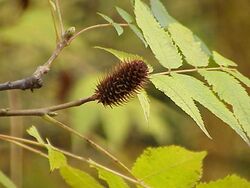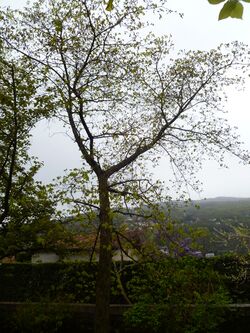Biology:Platycarya strobilacea
| Platycarya strobilacea | |
|---|---|

| |
| Autumn foliage and fruit | |
| Scientific classification | |
| Kingdom: | Plantae |
| Clade: | Tracheophytes |
| Clade: | Angiosperms |
| Clade: | Eudicots |
| Clade: | Rosids |
| Order: | Fagales |
| Family: | Juglandaceae |
| Genus: | Platycarya |
| Species: | P. strobilacea
|
| Binomial name | |
| Platycarya strobilacea Siebold & Zucc.
| |
Platycarya strobilacea is a species of flowering plant in the family Juglandaceae, formerly treated as comprising the single living species in Platycarya, though a second living species Platycarya longzhouensis is now recognized. It is native to eastern Asia in China , Vietnam, Korea, and Japan .[1][2]

It is a deciduous tree growing to 15 m tall. The leaves are usually pinnate, 15–30 cm long with 7–15 leaflets (rarely simple, or with up to 23 leaflets), the terminal leaflet present; the leaflets are 3–11 cm long and 1.5–3.5 cm broad. The flowers are catkins; the male (pollen) catkins are 2–15 cm long, the female catkins 2.5–5 cm long at maturity, hard and woody, superficially resembling a conifer cone with spirally arranged scales.[1][2] Galloyl pedunculagin can be found in P. strobilacea.[3]
References
- ↑ 1.0 1.1 Flora of China: Platycarya
- ↑ 2.0 2.1 Flora of China: Platycarya strobilacea
- ↑ Ueno, T.; Miyanaga, T.; Kawakami, F.; Okano, M.; Tanaka, T.; Ohtsuki, K. (2002). "Further characterization of galloyl pedunculagin as an effective autophosphorylation inhibitor of C-kinase in vitro". Biological & Pharmaceutical Bulletin 25 (11): 1401–1404. doi:10.1248/bpb.25.1401. PMID 12419947.
Wikidata ☰ Q147341 entry
 |

